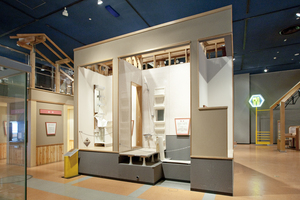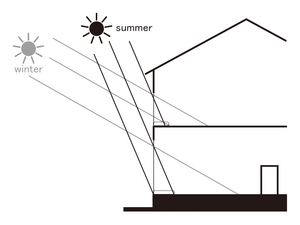Nagoya City Science Museum
TOP > Exhibition Guide > Keyword Search > Starting with "F" > function > Function of a House 2: Experiments
Function of a House 2: Experiments



Purpose of Exhibition
A "house" is built carefully so that we can live comfortably in it. Some necessary functions are hidden within a house, but we are hardly aware of them in our daily lives. This exhibit allows you to experience these functions through simple experiments.
Additional Knowledge
The following are the most basic functions of a house.
(1) Shutting Out the RainIf we get wet in the rain, we lose our body heat and get a cold. In particular, there is a rainy season in Japan, so roofs are necessary to shut out the rain. An old Japanese house was equipped with a long and strong roof made of thatch called "Kayabuki" which rain runs down, and no rain was allowed to come in a house. Since kawara tiles and copper plates were expensive, they were only used for castles, temples and shrines. Later on, instead of thatch, a plate took over, and light kawara tiles and rubber sheets are currently in use.
(2) The Sun and EavesThe sunlight in winter makes us warm and comfortable. But if it is on a hot summer day, it is not only unpleasant but it also causes sunburn. Not only that, it is even more dangerous for the elderly and children because it may bring about heatstroke. An eave, which is an extension of a roof, shuts out the sunlight in summer, and can be adjusted so that the sunlight can be invited into a house in winter. Since Japan stretches from north to south and its elevation of the sun differs depending on where you are, the length of an eave also varies.
(Figure: Elevation of the Sun and Eaves)(3) Temperature and HumidityIf a room's temperature and humidity are too high or too low, we feel uncomfortable. Windows and doors are built to ventilate when it is humid and hot in summer. And they keep warm air inside in winter.
(4) WindbreakIf you are drenched with rain and exposed to wind when climbing a mountain, it is possible to die of cold even in summer. Dying of cold does not actually mean being frozen to death. Even in summer, if much heat in our body is lost, we are likely to die. Therefore, a house needs a function of shutting out wind as well. Additionally, wise ideas such as preventing a house from being blown away and destroyed by a tornado or a typhoon is necessary. In Okinawa, for example, people prepare for typhoons by surrounding their house with stone hedges.
Article by Tetsuro Ojio, curator
